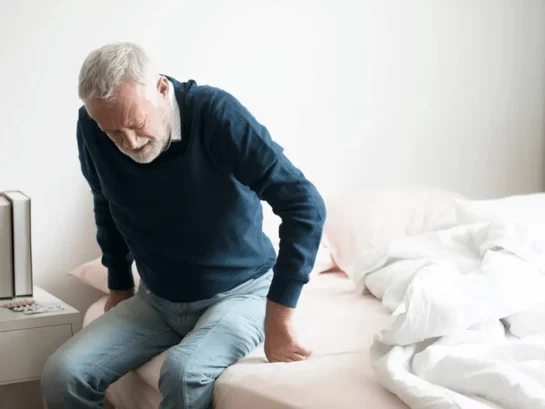Many people experience back pain in their life, especially as they get older. As our bones get worn down by the constant wear and tear of living, it’s a natural part of the aging process. While some back pain can seem expected, not all back pain should be ignored or brushed off. If you have been diagnosed with osteoporosis or low bone density, you could be suffering from a spinal compression fracture. The pain and immobility of these fractures can greatly interfere with quality of life and make it harder to live independently. Treating spinal compression fractures and getting them diagnosed early is the only way to prevent long-term effects.

What Is a Compression Fracture?
A compression fracture occurs when the vertebrae in the spine are pushed together and collapse. These fractures rarely occur in the upper back, but they can technically occur anywhere in the spine. Since they can be confused for general back pain or symptoms of a normal part of aging, many compression fractures go untreated or misdiagnosed.
While they are most common in women, compression fractures are typically found among people over the age of 50. Studies have shown that 25% of postmenopausal women will experience one in their lifetime.
Causes of Compression Fractures
Despite their name, since compression fractures occur gradually, they often only cause mild back pain, making them hard to diagnose early. They are often caused by:
- Osteoporosis – This condition occurs when the bones lose minerals faster than the body can replace them, causing the bones to become weaker and more brittle. Osteoporosis is the most common cause of spinal fractures and can also flatten the vertebrae, rounding the spine and increasing pressure.
- Metastatic disease – This occurs when cancer from a tumor elsewhere in the body migrates to the bones, weakening vertebrae as they grow.
- Falls or Trauma – If the spine has already been injured or weakened, there is a greater chance that fracture will occur, although this is more uncommon.
Long-Term Effects of Compression Fractures
The long-term effects of compression fractures can diminish the quality of life, resulting in:
- Chronic pain. Since mild back pain is assumed to be a normal part of aging, many people don’t seek treatment until multiple compression fractures have occurred. These fractures can cause the main portion of the vertebrae to collapse, causing immense pain and even changing the shape of the spine. For older patients, this can lead to a loss of mobility.
- Kyphosis. When spinal fractures are severe enough, they can cause a condition known as kyphosis. This is a forward curvature of the spine that causes a hunched posture. Kyphosis not only causes back pain, but it can also result in additional strains to the body from supporting the hunched position.
- Loss of height. As compression fractures weaken the spine or change its shape, some people lose height as their spine shortens.
In severe cases, daily functions like standing, walking, breathing, and turning your head can become a challenge. The long-term effects of compression fractures can seep into everyday life, making it harder to live unassisted or to keep doing the activities you love.
Treatment Options
The good news is that most of the long-term effects of spinal compression fractures can be prevented with early diagnosis and treatment. Compression fractures can heal on their own within two to three months. There are nonsurgical treatments that include pain medication, the use of ice or heat, wearing a back brace, doing lumbar compression fracture exercises, trying to alleviate the pain through rest, and following injury prevention strategies.
If symptoms continue to worsen, or surgery is suggested to help with spinal instability, two common surgical options are offered.
- Vertebroplasty – In this minimally invasive procedure, bone cement is injected into the collapsed vertebra using x-ray guidance and a small needle. The cement quickly hardens and stabilizes the fracture using mechanical support.
- Kyphoplasty – Although similar to vertebroplasty, kyphoplasty involves creating two small incisions before the injection of the bone cement. Two balloons are inserted and inflated to expand the space where the cement is filled. With this procedure, most of the height of the spine is restored.
Spinal compression fractures can have many long-term effects that will interfere with your quality of life. If you are experiencing back pain, consider talking with an expert. The specialists at Neurosurgical Associates of Central New Jersey have broad expertise with spinal compression fractures. To schedule an appointment with one of our experts, contact us today.



